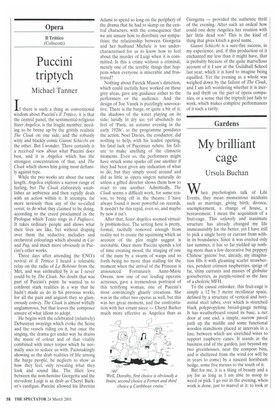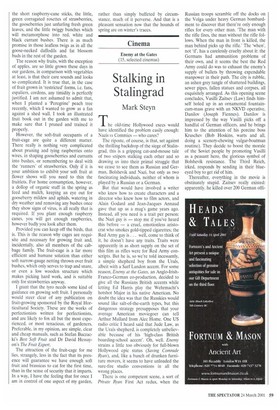Gardens
My brilliant cage
Ursula Buchan
When psychologists talk of Life Events, they mean momentous incidents such as marriage, giving birth, divorce, unemployment, a change of house, a bereavement. I mean the acquisition of a fruit-cage. This unlovely and inanimate structure has already changed my life immeasurably for the better, yet I have still to pick a single berry or currant from within its boundaries. Since it was erected only last summer, it has so far yielded up nothing more than a few decorative but peppery Chinese 'greens' but, already, my imagination fills it with gleaming scarlet strawberries, pendent crimson raspberries, sprigs of fat, shiny currants and masses of globular gooseberries, as purple-veined as the face of a choleric MFH.
To the casual onlooker, this fruit-cage is simply a 12 by 5 metre rectilinear space, defined by a structure of vertical and horizontal steel tubes, over which is stretched black polypropylene broad-gauge netting. It has weatherboard round its base, a net door at one end, a simple, narrow paved path up the middle and some functional wooden stanchions placed at intervals in a line, between which are stretched wires to support raspberry canes. It stands at the business end of the garden, just beyond my two greenhouses, near the compost bins, and is sheltered from the wind (or will be in years to come) by a nascent hornbeam hedge, some five metres to the south of it.
But for me, it is a thing of beauty and a joy for as long as I am able to stoop to weed or pick. I go out in the evening, when work is done, just to marvel at it: to look at
the short raspberry-cane sticks, the little, green corrugated rosettes of strawberries, the gooseberries just unfurling fresh green leaves, and the little twiggy bunches which will metamorphose into red, white and black currant bushes. There is as much promise in those leafless twigs as in all the goose-necked daffodils and fat blossom buds in the rest of the garden.
The reason why fruits, with the exception of apples, are so little grown these days in our gardens, in comparison with vegetables at least, is that their care sounds and looks so complicated. It is true that, in the case of fruit grown in 'restricted' forms, i.e. fans, espaliers, cordons, any timidity is perfectly justified. I am not ashamed to admit that, when I planted a 'Peregrine' peach tree recently, which I wanted to grow as a fan against a shed wall, I took an illustrated fruit book out in the garden with me to make sure that I pruned and trained it properly.
However, the soft-fruit occupants of a fruit-cage are quite a different matter. There really is nothing very complicated about pruning and tying raspberries onto wires, in shaping gooseberries and currants into bushes, or remembering to deal with the `runners' of strawberries. Only if it is your ambition to exhibit your soft fruit at flower shows will you need to thin the fruitlets. For home consumption, however, a dollop of organic stuff in the spring as feed and mulch, keeping an eye out for gooseberry mildew and aphids, watering in dry weather and removing any bushes once they show signs of virus, is all really that is required. If you plant enough raspberry canes, you will get enough raspberries, however badly you look after them.
Provided you can keep off the birds, that is. This is the reason why cages are requisite and necessary for growing fruit and, incidentally, also all members of the cabbage family. The fruit-cage is a far more efficient and humane solution than either soft narrow-gauge netting thrown over fruit bushes, which only serves to trap and snare, or even a low wooden structure which makes picking hard work, and is suitable only for strawberries anyway.
I grant that the tyro needs some kind of guidance on growing soft fruit. I personally would steer clear of any publication on fruit-growing sponsored by the Royal Horticultural Society. These are the works of perfectionists written for perfectionists, and are likely to fox all but the most experienced, or most tenacious, of gardeners. Preferable, in my opinion, are simple, clear and cheap manuals, such as Stefan Buczacki's Best Soft Fruit and Dr David Hessayon's The Fruit Expert.
The attraction of the fruit-cage for me lies, strangely, less in the fact that its presence will guarantee we have enough soft fruit and brassicas to eat for the first time, than in the sense of security that it imparts. In a way, I have the feeling that for once I am in control of one aspect of my garden, rather than simply buffeted by circumstance, much of it perverse. And that is a pleasant sensation now that the hounds of Spring are on winter's traces.















































































 Previous page
Previous page